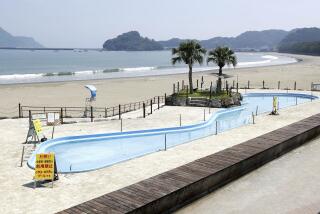Quake Leaves 2 Dead, 160 Hurt in Japan, Rattles Windows in S. Korea
- Share via
TOKYO — A powerful earthquake hit southwestern Japan on Saturday, killing two people, injuring at least 160 and leaving power outages, twisted roads and burning houses in its wake.
Hiroshima, 430 miles southwest of Tokyo, was hit hardest by the magnitude 6.4 quake, which struck at 3:28 p.m. and rattled windows as far as South Korea.
A 50-year-old homemaker, Kyoko Takeuchi, died in neighboring Ehime prefecture when a balcony fell on her. An 80-year-old woman, Tomoe Yamasaki, was killed in Hiroshima when she was buried under rubble from a collapsed wall.
Elsewhere, dozens of people were caught in elevators, and hundreds of homes lost power. Conventional and bullet train service was suspended while crews checked for twisted tracks and collapsed rail beds. But two nuclear power plants, one a mere 40 miles from the epicenter, were undamaged, and no tidal wave warning was issued.
“I panicked as the shaking continued for what seemed like a long time, although it was maybe only 30 seconds,” Masahiro Taniguchi, a worker at the Contemporary Art Museum in Hiroshima, said by telephone. “We had no warning. It’s the biggest earthquake I’ve ever felt.”
Katsuya Kobayashi, a priest at Hiroshima’s Heian Baptist Church, said many of his elderly parishioners who live alone have been psychologically hurt and are suffering acute depression. “Some had heart attacks and had to go to the hospital,” he added. “People here are very, very shocked.”
A 6.4 earthquake can knock people over and destroy buildings that have not been reinforced. Japan might have suffered far worse damage Saturday if the epicenter had not been offshore and, at 38 miles under Hiroshima Bay, relatively deep.
Ten hours after the earthquake, meteorological agencies reported that there had been 228 aftershocks, including 10 that could be felt by shaken-up residents. But experts downplayed the chance of another major jolt soon. By early today, rail and major arterial road service had been restored.
In part because of Japan’s strict earthquake building codes, larger buildings suffered no major structural damage, Hiroshima officials reported. The nation straddles three of the tectonic plates that cover Earth’s surface, making it one of the most earthquake-prone areas in the world.
Ryohei Morimoto, a professor emeritus of seismology at Tokyo University, said the area abutting Hiroshima and Ehime prefectures has in recent times produced on average a major earthquake every 50 years. Eleven people were killed in a 1905 quake in Hiroshima, and two were killed in 1949 in the nearby town of Kure.
The number of tremors and the level of volcanic activity in central Japan have increased, prompting Japan’s Meteorological Agency last month to order a study on whether Mt. Fuji might erupt for the first time since 1707.
On average, 10 tremors a year are recorded under Mt. Fuji. In the last three months of 2000, however, the agency recorded 497. Since then, the number has declined somewhat.
In recent years, the Japanese government has come under severe criticism for its weak crisis management. Prime Minister Yoshiro Mori, in particular, was publicly slammed for his decision to keep playing golf last month after learning that the U.S. nuclear submarine Greeneville had hit a Japanese fisheries training vessel in waters off Hawaii, killing nine.
Mori, in Russia on Saturday for a summit with President Vladimir V. Putin, quickly issued a statement that sought to reassure the Japanese public that the government was responding in every way possible to the quake.
*
Hisako Ueno in The Times’ Tokyo Bureau contributed to this report.
More to Read
Sign up for Essential California
The most important California stories and recommendations in your inbox every morning.
You may occasionally receive promotional content from the Los Angeles Times.













